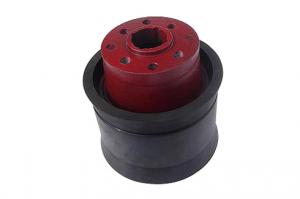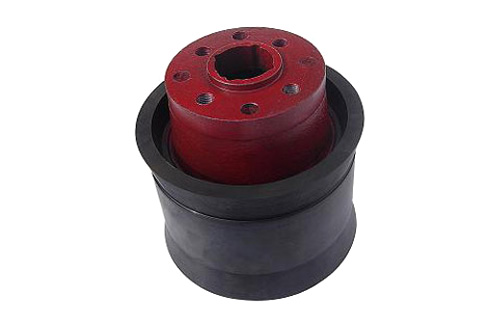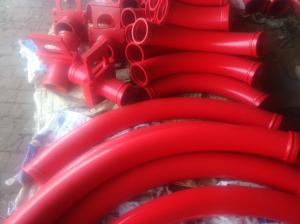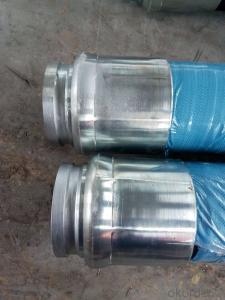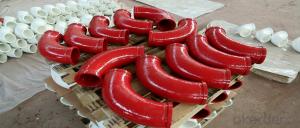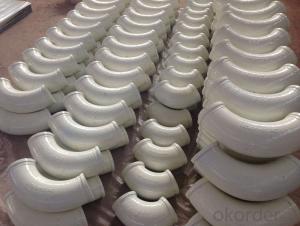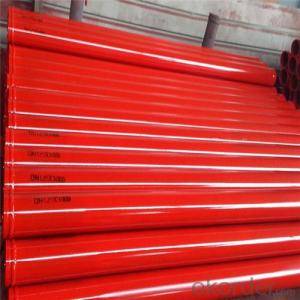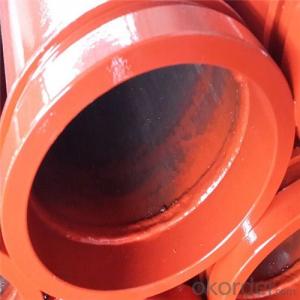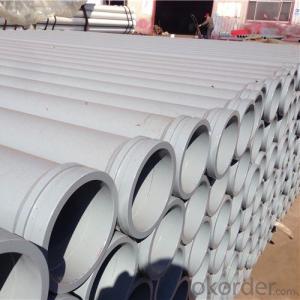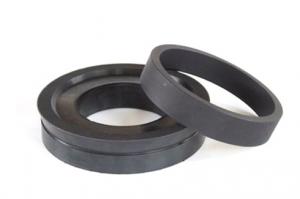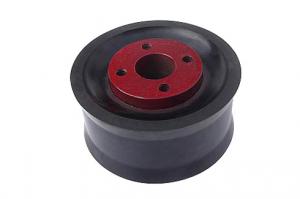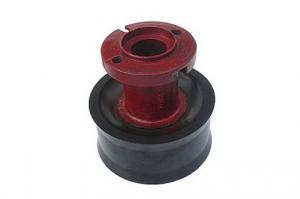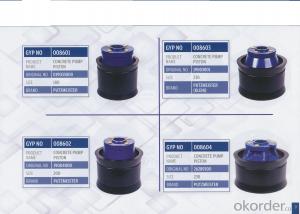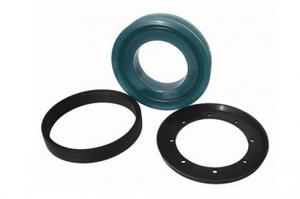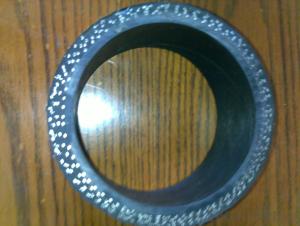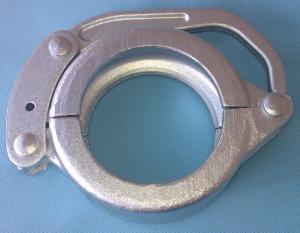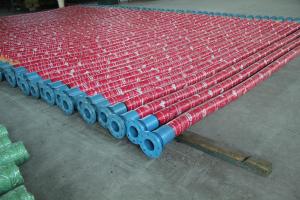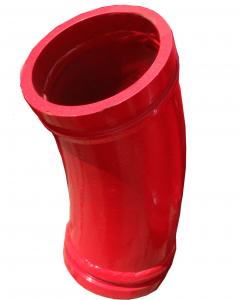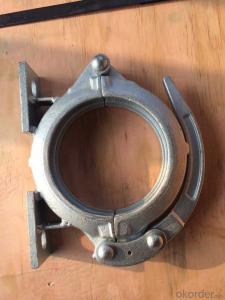Concrete Pump Putzmeister Ram Piston DN200 & DN230
- Loading Port:
- China Main Port
- Payment Terms:
- TT OR LC
- Min Order Qty:
- -
- Supply Capability:
- -
OKorder Service Pledge
Quality Product, Order Online Tracking, Timely Delivery
OKorder Financial Service
Credit Rating, Credit Services, Credit Purchasing
You Might Also Like
Brand: Schwing, Putzmeister, Sany,Zoomlion, IHI, Kyokuto, Sermac
Other products:
1) ST52 steel pipe, elbow, reducer
2) Wear-resisting board and Cuts ink
3) Coupling and seal ring for Putzmeister,Schwing, Sany
4) Rubber hose
5) Cleaning series and others
- Q: How can one ensure proper documentation and record-keeping for concrete pump spare parts?
- To guarantee the appropriate documentation and record-keeping for concrete pump spare parts, one can take several measures: 1. Establishing a systematic inventory management system: A well-organized inventory management system should be implemented to track all spare parts effectively. Each part should be assigned unique codes or identification numbers, and a comprehensive inventory list should be maintained. 2. Maintaining accurate records: Detailed records should be created for each spare part, including its description, quantity, purchase date, supplier information, and cost. It is crucial to update this information regularly and make it easily accessible. 3. Implementing a standardized labeling system: Clear and consistent labels should be used on all spare parts to facilitate easy identification and location. This will minimize confusion and prevent misplacement. 4. Storing spare parts in a designated area: A specific storage area should be designated for spare parts, preferably a well-organized warehouse with proper shelving and sufficient space. This ensures secure and convenient storage. 5. Implementing a maintenance and repair schedule: A maintenance and repair schedule should be developed for the concrete pump and its spare parts. Regular inspections of all parts should be conducted, and any repairs or replacements should be documented and reflected in the inventory. 6. Training staff on documentation procedures: Employees responsible for managing spare parts should receive training on proper documentation procedures. This includes accurate recording, labeling, and updating of inventory records. 7. Performing periodic stock checks: Regular stock checks should be carried out to verify the accuracy of inventory records and identify any discrepancies. This helps identify missing or misplaced spare parts and ensures up-to-date documentation. 8. Implementing an integrated software system: An inventory management software system specifically designed for this purpose should be utilized. These systems automate documentation, track stock levels, and generate reports, enhancing efficiency and accuracy. By adhering to these measures, one can ensure proper documentation and record-keeping for concrete pump spare parts, reducing the risk of errors, improving efficiency, and guaranteeing the availability of the right spare parts when needed.
- Q: How can a malfunctioning remote control affect the pumping operation?
- A malfunctioning remote control can significantly impact the pumping operation in various ways. Firstly, a remote control is used to operate the pump remotely, allowing operators to control the pump's speed, direction, and other important settings from a distance. If the remote control malfunctions, operators may lose the ability to control the pump effectively, leading to delays or inefficiencies in the pumping operation. Secondly, a malfunctioning remote control may result in inconsistent or erratic commands being sent to the pump. This can lead to unstable pump performance, potentially causing fluctuations in flow rates, pressure, or other critical parameters. Such inconsistencies can affect the overall efficiency and effectiveness of the pumping operation. Additionally, a malfunctioning remote control can pose safety risks. For instance, if the remote control fails to transmit accurate commands, it can potentially result in the pump operating at undesirable speeds or pressures, which may lead to equipment damage or accidents. Moreover, if operators are unable to control the pump remotely during emergencies or hazardous situations, it could hinder their ability to promptly respond and mitigate risks. Furthermore, a malfunctioning remote control may also impact the monitoring and control systems associated with the pumping operation. Remote controls are often integrated with centralized monitoring systems, allowing operators to collect real-time data and receive alerts or alarms. If the remote control fails, it may disrupt the flow of critical information, making it challenging for operators to monitor the pump's performance, identify potential issues, or make informed decisions. In conclusion, a malfunctioning remote control can have detrimental effects on the pumping operation by impeding the ability to control the pump remotely, causing erratic pump performance, posing safety risks, and hindering the monitoring and control systems. Therefore, it is crucial to regularly inspect and maintain remote controls to ensure their proper functionality and minimize any potential disruptions to the pumping operation.
- Q: How often do I need to replace concrete pump spare parts?
- The frequency of replacing concrete pump spare parts largely depends on the usage and maintenance of the pump. However, it is generally recommended to inspect and replace worn-out or damaged parts regularly to ensure optimal performance and prevent any potential breakdowns.
- Q: What is the role of a concrete pump hopper agitator blade?
- The concrete pump hopper agitator blade is responsible for maintaining the consistency and flow of the concrete while it is being pumped. Its purpose is to mix the concrete in the hopper, preventing it from settling or becoming too thick. By continuously stirring the concrete, the agitator blade ensures that it maintains the correct consistency, making it easier to pump and ensuring a more even distribution of the material. This is especially important when working with large amounts of concrete or pumping over long distances, as it helps to prevent blockages and maintain a smooth and efficient pumping process. In summary, the agitator blade is essential for the successful operation of a concrete pump, ensuring that the concrete remains in a workable condition throughout the pumping process.
- Q: What are the indications of a damaged concrete pump boom?
- The indications of a damaged concrete pump boom may include cracks or fractures in the boom structure, leaks in hydraulic lines, inconsistent or reduced pumping pressure, abnormal vibrations or shaking during operation, and difficulty in maneuvering or extending the boom arm.
- Q: What are the different types of concrete pump rubber hoses?
- There are several different types of concrete pump rubber hoses available in the market. 1. Steel Wire Reinforced Hose: This is the most common type of concrete pump rubber hose. It is reinforced with multiple layers of steel wire to provide maximum strength and durability. Steel wire reinforced hoses are suitable for high-pressure applications and can handle the heavy pumping of concrete with ease. 2. Textile Reinforced Hose: This type of hose is reinforced with multiple layers of textile fabric, such as nylon or polyester. Textile reinforced hoses are generally lighter in weight compared to steel wire reinforced hoses, making them easier to handle and maneuver. They are suitable for medium-pressure applications and are commonly used in smaller concrete pumps. 3. Fabric Hose: Fabric hoses are made from a single layer of fabric, such as nylon or polyester. They are lightweight and flexible, making them easy to handle and transport. Fabric hoses are suitable for low-pressure applications and are commonly used in small-scale construction projects. 4. Composite Hose: Composite hoses are made from a combination of different materials, such as rubber and plastic. These hoses are lightweight and highly flexible, making them suitable for applications where maneuverability is crucial. Composite hoses are commonly used in smaller concrete pumps and can handle both low and medium pressure. 5. Flanged Hose: Flanged hoses have flanges attached at both ends of the hose, which are used to connect the hose to the pump and the nozzle. Flanged hoses provide a secure connection and prevent any leaks or disconnections during the pumping process. They are commonly used in high-pressure applications and are suitable for large-scale construction projects. Overall, the choice of concrete pump rubber hose depends on the specific requirements of the project, including the pressure, size, and type of concrete being pumped. It is important to select the right type of hose to ensure efficient and safe concrete pumping operations.
- Q: What are some common issues with concrete pump hoses and how can they be prevented?
- Some common issues with concrete pump hoses include hose blockages, hose leaks, and premature hose wear. These issues can be prevented by following proper maintenance and usage practices. 1. Hose Blockages: Concrete pump hoses can become blocked due to hardened concrete or debris. To prevent blockages, it is important to clean the hoses thoroughly after each use. Flushing the hoses with water or using a cleaning sponge ball can help remove any residue or build-up. Additionally, using the correct size and length of hose for the job can minimize the risk of blockages. 2. Hose Leaks: Leaks can occur due to wear and tear, improper connections, or damage to the hose. Regular inspection of the hoses is crucial to identify any signs of leakage. If any leaks are detected, they should be promptly repaired or replaced. Properly connecting and securing the hose fittings can also prevent leaks. 3. Premature Hose Wear: Concrete pump hoses can wear out over time due to factors like abrasion, bending, and exposure to harsh chemicals. To prevent premature wear, it is important to handle the hoses with care and avoid dragging them on rough surfaces. Using protective sleeves or guards can also provide additional protection against abrasion. Regularly inspecting the hoses for signs of wear and replacing them when necessary is essential. 4. Improper Storage: Improper storage of concrete pump hoses can lead to damage and reduce their lifespan. Hoses should be stored in a clean and dry environment, away from direct sunlight and extreme temperatures. Coiling the hoses properly and avoiding sharp bends or kinks can help maintain their integrity. 5. Incorrect Pressure: Exceeding the recommended pressure limits can cause the hose to burst or fail. It is important to ensure that the concrete pump is operated within the specified pressure range. Regularly inspecting the pressure gauges and monitoring the pumping process can help prevent over-pressurization. By following these preventive measures and conducting regular inspections and maintenance, the common issues associated with concrete pump hoses can be minimized, leading to improved performance and longevity of the hoses.
- Q: What is the purpose of a concrete pump cylinder?
- The purpose of a concrete pump cylinder is to provide the necessary pressure and force to transport and deliver concrete from the pump to the desired location. The cylinder is an essential component of a concrete pump, as it allows for the efficient movement of concrete through the pump system. The cylinder works by using hydraulic pressure to push the concrete through the pipeline, ensuring a continuous and smooth flow of concrete. It plays a crucial role in construction projects, enabling concrete to be precisely and efficiently placed in various locations, such as buildings, bridges, or other structures. By providing the necessary power and pressure, the concrete pump cylinder ensures that concrete can be transported over long distances, vertically or horizontally, with minimal effort and labor. Overall, its purpose is to facilitate the efficient and precise delivery of concrete, saving time and effort in construction projects.
- Q: How do I properly maintain and replace wear plates in concrete pump spare parts?
- Achieving optimal performance and durability for your equipment relies heavily on the proper maintenance and replacement of wear plates in concrete pump spare parts. To ensure that your wear plates are adequately maintained and replaced, the following steps can be taken: 1. Conduct regular inspections: It is crucial to regularly inspect the wear plates in your concrete pump spare parts in order to identify any signs of wear or damage. Look for visible indications such as cracks, excessive wear, or deterioration. 2. Thoroughly clean the area: Prior to replacing the wear plates, it is essential to thoroughly clean the surrounding area. Remove any debris, dirt, or hardened concrete that may be present. Utilize a pressure washer or wire brush to effectively clean the surface. 3. Measure the thickness of wear plates: Utilize a precision measuring tool to determine the thickness of the wear plates. Compare the current thickness with the manufacturer's recommended specifications to determine if replacement is necessary. If the wear plates are below the recommended thickness, replacement is required. 4. Remove the old wear plates: Carefully remove the old wear plates using the appropriate tools. Take note of their positions and any alignment marks to ensure proper installation of the new plates. 5. Prepare the new wear plates: Prior to installing the new wear plates, verify that they are the correct size and meet the required specifications for your concrete pump. Inspect the new plates for any defects or damage before proceeding. 6. Apply lubrication: Apply a thin layer of lubricant or anti-seize compound to the mating surface of the new wear plates. This will aid in preventing corrosion and facilitate future replacements. 7. Install the new wear plates: Position the new wear plates accurately, aligning them with any reference marks or indicators. Secure them tightly using suitable bolts or fasteners, taking care not to overtighten. 8. Test and check alignment: After installing the new wear plates, perform a test run of the concrete pump to ensure proper functionality. Check for any leaks, uncommon vibrations, or misalignments. If any issues are detected, address them promptly. 9. Establish a regular maintenance schedule: To prevent premature wear and damage to the wear plates, create a routine maintenance schedule. This may involve cleaning, lubricating, and inspecting the wear plates at specified intervals or after a certain number of operational hours. By adhering to these steps and adopting a proactive approach to wear plate maintenance and replacement, you can guarantee the seamless operation and extended lifespan of your concrete pump spare parts.
- Q: What are the key considerations when purchasing spare parts for a concrete pump?
- When buying spare parts for a concrete pump, there are several important factors to think about. These factors include making sure that the spare parts are compatible with the concrete pump's make and model, checking their quality and reliability, ensuring their availability, and considering their cost-effectiveness. First and foremost, it is crucial to make sure that the spare parts you purchase are suitable for the concrete pump you have. Concrete pumps come in different makes and models, and each may have specific requirements for spare parts. Therefore, it is essential to carefully match the specifications and requirements of the concrete pump with the spare parts you buy to ensure proper functionality and performance. The quality and reliability of the spare parts are also important considerations. Investing in high-quality spare parts can have a significant impact on the efficiency and lifespan of the concrete pump. It is advisable to choose spare parts from reputable manufacturers or suppliers who have a proven track record of producing reliable products. Doing thorough research and reading customer reviews can help assess the quality and reliability of the spare parts. Availability is another crucial factor to consider when purchasing spare parts for a concrete pump. It is important to ensure that the spare parts you need are easily accessible, either from local suppliers or through efficient delivery channels. Delays in obtaining the necessary spare parts can result in extended downtime and increased costs. Therefore, it is recommended to choose suppliers with a reliable and efficient distribution network. Cost-effectiveness is also a key consideration when buying spare parts. While it is important to prioritize quality and reliability, it is equally important to find spare parts that offer good value for money. Comparing prices from different suppliers and considering the lifespan and potential maintenance costs of the spare parts can help make a cost-effective decision. It is crucial to strike a balance between cost and quality to ensure the best return on investment. In conclusion, when purchasing spare parts for a concrete pump, it is important to consider compatibility, quality, availability, and cost-effectiveness. By carefully evaluating these key factors, you can ensure that the spare parts you choose will meet the specific needs of your concrete pump, maintain its performance and reliability, and provide value for your money.
Send your message to us
Concrete Pump Putzmeister Ram Piston DN200 & DN230
- Loading Port:
- China Main Port
- Payment Terms:
- TT OR LC
- Min Order Qty:
- -
- Supply Capability:
- -
OKorder Service Pledge
Quality Product, Order Online Tracking, Timely Delivery
OKorder Financial Service
Credit Rating, Credit Services, Credit Purchasing
Similar products
Hot products
Hot Searches
Related keywords
